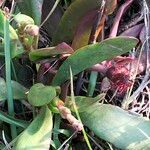Perennials, usually with several basal rosettes, more or less branched, with carnose to slightly woody branches, with old leaves remaining attached to stem. Leaves oblong-elliptic, rarely linear-lanceolate or obovate to orbicular, 20-80(-150) x (4-)6-15(-25) mm, acute to rounded, flat or slightly convex above, more or less convex below, spreading, rarely somewhat recurved in the north-east, glabrous to pubescent, with or without marginal cilia, green to yellowish green to brown. Inflorescence an elongate, sometimes a spike-like thyrse with many dense dichasia stalked or sessile (i.e. part-inflorescences are produced from (2-)3-5(-7) nodes of central axis), with peduncle 0.l-0.2(-0.4) m long and glabrous to pubescent. Calyx: lobes oblong-triangular, l.5-2(-3) mm long, obtuse, rarely acute, glabrous or with recurved hairs or papillae and marginal cilia, fleshy, green to brown. Corolla tubular to almost cylindrical, fused basally for 0.5-0.8 mm, cream, rarely white; lobes panduriform, 3-3.5(-4.5) mm long, each with an ellipsoid dorsal appendage in terminal position and with membranous petal apex on inside. Stamens with yellow anthers. Squamae oblong-cuneate to almost square, 0.6-1 x 0.4-0.5 mm, usually slightly emarginate, first abruptly, later gradually constricted towards base, fleshy, yellow.
Perennial succulent, several basal rosettes, branched, erect, carnose to woody, 0.150.45 m when in flower, old leaves not deciduous. Leaves oblong-elliptic, 20-80 x 6-15 mm, acute to rounded, flat above, convex below, glabrous to pubescent, with or without marginal cilia, green to brown. Inflorescence an elongate, terminal thyrse with several dense stalked or sessile dichasia from 3-5 nodes; flowers sessile; peduncle 0.1-0.2 m long, glabrous to pubescent. Calyx fleshy, green to brown, hairy, marginal cilia. Corolla tubular, fused 0.5-0.8 mm, cream-coloured; lobes panduriform, 3.0-3.5 mm long, terminal ellipsoid dorsal appendage present, apex membranous on inside. Flowering time Sept.-Dec.
Woody or fleshy, branched perennial, with several basal rosettes, 50-250 mm tall. Leaves oblong-elliptic to orbicular, flat and slightly convex above and convex below, 20-80 x 6-15 mm, glabrous to pubescent. Flowers, in many dense stalked or sessile clusters, in an elongated to spike-like inflorescence, on a pubescent peduncle 0.1-0.2 m long, tubular, petals 3-3.5 mm long, fused in lower 0.8 mm, with a fleshy, terminal appendage, cream to white.
Tufted perennial with fleshy branches. Leaves oblong-elliptic, to orbicular, glabrous or pubescent, margins often ciliate. Flowers in small clusters forming elongate panicles, white to cream-coloured, ± 4 mm long.

